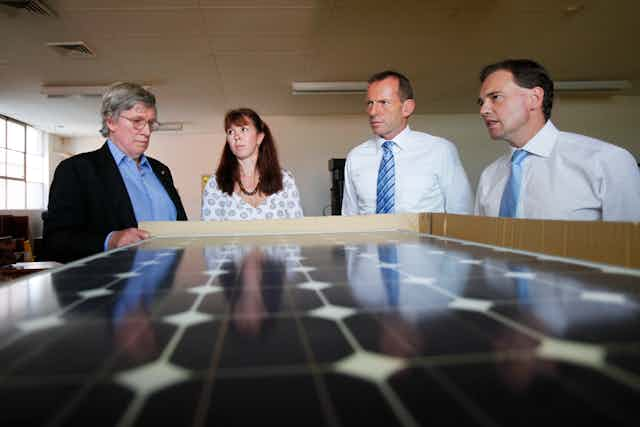The Abbott Government’s Direct Action Plan (DAP) - its substitute for Labor’s carbon tax - could be made to work if imagination, innovation and leadership are applied to its design. Submissions on its main feature, the Emissions Reduction Fund, closed on Monday.
My submission is founded on a belief that our generation must make the most of every opportunity for effective action on climate change.
So far, the government has provided little detail about how Direct Action or the Emissions Reduction Fund would work. Given there is a lot of room to move within the rough guidelines provided, I have tried to develop a submission that builds on the spirit of Direct Action to create an economically rigorous framework for emissions reduction.
The key to making Direct Action work, I believe, lies in little publicised advice by the Coalition’s consultant, Frontier Economics.
Danny Price, Managing Director of Frontier Economics (Australia), told ABC Lateline that “the direction (sic) action policy has always had a penalty included in it”. The penalty would apply to an emitter that went over its limit on carbon-equivalent emissions (CO2e).
This reflects the Coalition’s Direct Action Plan (available on Minister Hunt’s website) which states: “Businesses that undertake activity with an emissions level above their ‘business as usual’ levels will incur a financial penalty. The value of penalties will be on a sliding scale at levels commensurate with the size of the business and the extent to which they exceed their ‘business as usual’ levels.”
By building on those limits and penalties we can develop governance arrangements for the plan’s central feature, the Emissions Reduction Fund (ERF).
The Emissions Reduction Fund would be used to buy up and thereby reduce CO2e emitted by those businesses required to report emissions: the “big emitters”. These yearly reports have been required by law since the Howard years. Under the Emissions Reduction Fund governance arrangements, emissions in 2012-2013 would form the baseline limit. This means businesses should not emit more than they did that year.
We know that emissions from electricity generation have been falling overall in recent years at least partly as a result of significant efficiency gains and major expansion of renewable energy. This makes it easier for the government to reach its target: reducing CO2e emissions by 5% of the year 2000 levels by 2020 (the “5% target”).
If CO2e emissions did not fall fast enough in any particular year for the 5% target to be reached, each big emitter’s baseline limit would be reduced as needed to progress to that national 5% target.
I suggest that to help individual big emitters move to their adjusted baseline limits, a non-government “emissions exchange” would be licenced for emitters to buy or sell part (or all) of their baseline limits. New or expanding businesses could buy baseline limits through the emissions exchange.
In addition, big emitters could sell baseline limits to the Emission Reduction Fund, as announced by the government.
As now, emissions reports would be subject to independent audit to prevent fraud.
As suggested by Frontier Economics, there must be incentives for big emitters to stay under the ceiling of their annual baseline limit. It must not be profitable to break the law or the ethical obligation to protect the atmosphere from pollution. Those who breached their baseline limits must face penalties.
There is also room for more conventional direct action. Remember Malcolm Turnbull’s initiative to ban conventional, inefficient light bulbs? It was a simple piece of regulation to which we all adapted effortlessly.
The business case is clear too. A Melbourne cold storage business has massively reduced energy waste by replacing hot incandescent light bulbs with LEDs; it is now easier to keep coolrooms cool and cost is recovered under two years.
Yet, more can be done. The ERF governance arrangements should include simple regulations for such thing as more efficient cars, solar-efficient house design, low energy heating and cooling, smarter industrial buildings and many more proven, economic solutions to unnecessary pollution of our atmosphere.
A number of the proposals I have suggested lend themselves to implementation by states, territories and local government, consistent with government policy. This should be applied in all practicable instances.
States, territories and local government should be “contracted” to implement these governance arrangements, through inter-governmental agreements. This would be most important in respect of Direct Action emission standards. It would be most important that the Commonwealth set clear standards to be met in implementation.
Each of these suggestions is consistent with the advice from Frontier Economics that underpins the government’s Direct Action Plan.
These suggestions take a step back from the strident opposition to the Direct Action Plan. Rather than oppose a policy to which the government is fervently committed, I take environment minister Greg Hunt at face value when he says that he wants input on the design details to achieve the 5% target.
It also accepts that the published policy - a single-page outline - really does fully describe the policy framework as it now stands, incomplete and waiting to be fleshed out without preconceived ideas about how the system could work. Most of all, it accepts a moral obligation to do as much as possible as soon as possible rather than wait for a change of policy.
If however, the public Direct Action policy is not a true reflection of government policy, these suggestions may not be welcomed.

